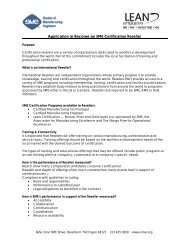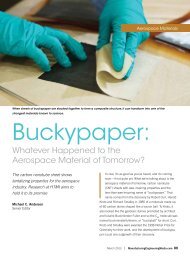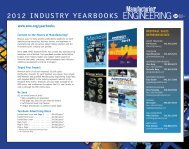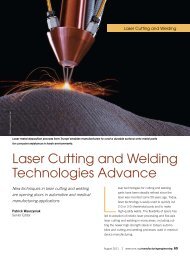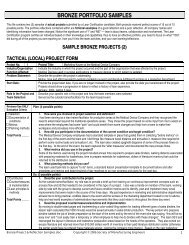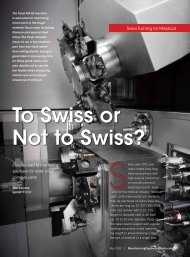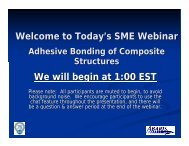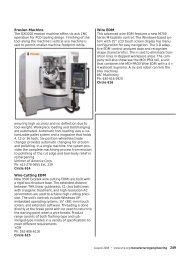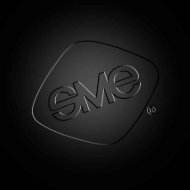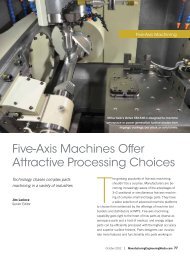The RAPID 2013 Conference & Exposition Directory - Society of ...
The RAPID 2013 Conference & Exposition Directory - Society of ...
The RAPID 2013 Conference & Exposition Directory - Society of ...
You also want an ePaper? Increase the reach of your titles
YUMPU automatically turns print PDFs into web optimized ePapers that Google loves.
used in both configurations. Comparisons <strong>of</strong> weight, cost, and<br />
flight performance were performed, and this work describes the<br />
findings in each area.<br />
Medical and Dental Applications<br />
10 am–5 pm<br />
Medical applications including dental continue to grow in use<br />
and scope. <strong>The</strong>se include, but are not limited to, prototyping,<br />
bio-modeling/anatomical modeling and direct production <strong>of</strong><br />
implantable metal implants or scaffolds for tissue engineering.<br />
10–10:55 am<br />
Medicine Meeting AM Technology:<br />
Close Encounters <strong>of</strong> the Third Kind?<br />
Jules Poukens, Pr<strong>of</strong>essor, MD, DMD, PhD,<br />
University Hasselt Belgium<br />
CAD/CAM and Additive Manufacturing (AM) are getting more<br />
attention in the medical sector, especially in cranio-maxill<strong>of</strong>acial<br />
surgery where defects <strong>of</strong> the face (e.g., absence <strong>of</strong> a nose, ear,<br />
or eye) have an important psycho-social impact. Radiological,<br />
optical, or laser scans <strong>of</strong> the patient are converted into a virtual<br />
three-dimensional patient with subsequent virtual design <strong>of</strong> a<br />
medical device or implant. AM methods enable the production<br />
<strong>of</strong> custom implants and prosthesis in a solid or resorbable<br />
material, or even in multiple materials. <strong>The</strong> introduction <strong>of</strong> AM<br />
and related technologies in medicine are a breakthrough in the<br />
treatment <strong>of</strong> very complex patient cases that were previously<br />
untreatable. What’s more, they are reducing operating time<br />
and patient discomfort. This progress is serving as a “stepping<br />
stone” to the 3D printing <strong>of</strong> organs in the future in order to<br />
improve life quality <strong>of</strong> the patient. Introduction <strong>of</strong> engineering in<br />
medicine looks as a small step for an engineer, but represents a<br />
giant leap in medical history.<br />
11–11:25 am<br />
Direct Comparison <strong>of</strong> DMLS and<br />
EBM Ti6Al4V Performance in Vivo<br />
Emanuele Magalini, R&D Manager, Eurocoating s.p.a.<br />
Additive Manufacturing (AM) techniques, such as EBM and<br />
DMLS, using Ti6Al4V powder, are suitable to produce implants<br />
with porous surfaces named “trabecular-like” structures.<br />
Solid part and trabecular surface are produced in the same<br />
manufacturing step. <strong>The</strong> importance <strong>of</strong> mimicking human<br />
trabecular structure on implant surfaces is confirmed by<br />
investigations that showed a substantial increase in implant<br />
fixation strength when highly complex networks are used.<br />
Our contribution to this thesis comes through in vivo tests done<br />
in goat model. <strong>The</strong> same trabecular structure was manufactured<br />
using either EBM or DMLS. Specimens with different pores<br />
and struts sizes were obtained, due to dissimilar resolution<br />
limits existing for the two techniques. Explanations occurred at<br />
four weeks after surgery for one group and at 15 weeks for the<br />
second group. Each goat received EBM and DMLS specimens for<br />
mechanical and histological analysis.<br />
11:30–11:55 am<br />
Additive Manufacturing for Surgical Implants:<br />
It’s the Present and the Future<br />
Andy Christensen, President, Medical Modeling Inc.<br />
In the last decade since Electron Beam Melting (EBM) was<br />
introduced it has been applied to produce real-world production<br />
parts in the aerospace and medical device fields. In the<br />
medical device field, EBM has been used to displace traditional<br />
manufacturing techniques for existing products as well as enabling<br />
production <strong>of</strong> completely new products not otherwise possible to<br />
produce. <strong>The</strong>se unique opportunities to provide value and enable<br />
novel devices are where much <strong>of</strong> the focus will continue to be<br />
placed. This talk will focus on how additive manufacturing is<br />
being used today for production <strong>of</strong> implantable medical devices in<br />
addition to where the presenter feels the market will continue to<br />
grow over the coming years for these technologies.<br />
1:30–1:55 pm<br />
Using Additive Manufacturing to Produce Custom<br />
Prosthetic Attachments for Wounded Warriors<br />
Peter Liacouras, PhD, Director <strong>of</strong> Service, 3D Medical<br />
Applications Center, Walter Reed National Military Medical<br />
Center Bethesda<br />
Kevin Wurth, Director <strong>of</strong> Operations, 3D Medical Applications<br />
Center, Walter Reed National Military Medical Center Bethesda<br />
<strong>The</strong> technology in the design and function <strong>of</strong> the prosthetics the<br />
military uses to restore function and mobility to our wounded<br />
warriors is highly advanced and unique. <strong>The</strong>se typically young<br />
6/<strong>2013</strong> – <strong>RAPID</strong> 35





